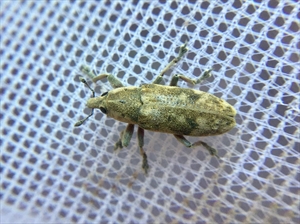- Restricted distribution. In Fiji. A weevil on Amaranthus species, both vegetables and weeds. Commonly called 'pigweeds'.
- Important pest. Damage by grubs (larvae) boring stems and branches. They spread Fusarium species causing decay and cankers. Pupate inside stem at base. Adults feed on leaves. Larvae spread in stems and adults on the wing.
- Natural enemies: Not reported; note, used as biocontrol of Amaranthus spinosus - major weed in Thailand.
- Cultural control: weed - especially wild amaranths; avoid adjacent overlapping crops; monitor frequently and pull out and burn wilted plants; collect and burn crop remains at harvest.
- Chemical control: PDPs (botanicals), e.g., neem, pyrethrum and derris; or synthetic products, e.g., malathion and pyrethroids. Note, effectiveness in doubt as larvae concealed within stems and branches.








